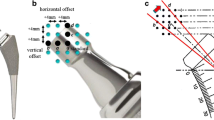Abstract
Purpose
The influence of physiologic femoral bowing on range of motion (ROM) after total hip arthroplasty (THA) remains unknown. The purpose of this study was to investigate the morphology of the femur in patients who underwent THA, and to analyze the influence of femoral bowing on ROM due to implant impingement after THA.
Methods
The ROM was calculated from 100 hips in 90 patients who underwent THA using computed tomography data with a 3D dynamic analysis software. Lateral and anterior bowing angles of the femur were measured. A modular implant (Modulus system, Lima Corporate, Villanova di San Daniele del Friuli, Italy) was used for simulation. In all subjects, cup inclination, anteversion, and stem anteversion were set to 40°, 15°, and 30°, respectively. Multiple linear regression analyses were performed to assess the relationship between the morphology of the femur and ROM.
Results
Lateral bowing of the femur was demonstrated to be significantly correlated with age (r = 0.361, p < 0.001) and female sex (r = 0.315, p = 0.001). Lateral bowing of the femur was significantly positively correlated with flexion and internal rotation (Int-R) with 90° flexion. Anterior bowing was significantly associated with decreasing flexion, decreasing Int-R with 90° flexion and increasing Int-R with 45° flexion and 15° adduction.
Conclusions
A ROM-optimized cup position cannot be calculated from femoral stem anteversion values alone; therefore, when surgeons position the cup in relation to the femoral stem anteversion, the influence of femoral bowing may also require consideration.






Similar content being viewed by others
References
Shon WY, Baldini T, Peterson MG et al (2005) Impingement in total hip arthroplasty a study of retrieved acetabular components. J Arthroplast 20:427–435
Bader R, Steinhauser E, Zimmermann S et al (2004) Differences between the wear couples metal-on-polyethylene and ceramic-on-ceramic in the stability against dislocation of total hip replacement. J Mater Sci Mater Med 15:711–718
Barrack RL (2003) Dislocation after total hip arthroplasty: implant design and orientation. J Am Acad Orthop Surg 11:89–99
Widmer KH, Zurfluh B (2004) Compliant positioning of total hip components for optimal range of motion. J Orthop Res 22:815–821
Shoji T, Yamasaki T, Izumi S et al (2016) The influence of stem offset and neck shaft angles on the range of motion in total hip arthroplasty. Int Orthop 40:245–253
Lasam MP, Lee KJ, Chang CB et al (2013) Femoral lateral bowing and varus condylar orientation are prevalent and affect axial alignment of TKA in Koreans. Clin Orthop Relat Res 471:1472–1483
Matsumoto T, Hashimura M, Takayama K et al (2015) A radiographic analysis of alignment of the lower extremities — initiation and progression of varus-type knee osteoarthritis. Osteoarthr Cartil 23:217–223
Nakano N, Matsumoto T, Hashimura M et al (2016) Coronal lower alignment in normal knees- a radiographic analysis of 797 normal knee subjects. Knee 23:209–213
Renkawitz T, Haimerl M, Dohmen L et al (2012) The association between Femoral Tilt and impingement-free range-of-motion in total hip arthroplasty. BMC Musculoskelet Disord 13:65
Müller M, Abdel MP, Wassilew GI et al (2015) Do post-operative changes of neck-shaft angle and femoral component anteversion have an effect on clinical outcome following uncemented total hip arthroplasty? Bone Joint J 97-B:1615–1622
Imai N, Ito T, Suda K et al (2013) Pelvic flexion measurement from lateral projection radiographs is clinically reliable. Clin Orthop Relat Res 471:1271–1276
Murray DW (1993) The definition and measurement of acetabular orientation. J Bone Joint Surg Br 75:228–232
Sugano N, Tsuda K, Miki H et al (2012) Dynamic measurements of hip movement in deep bending activities after total hip arthroplasty using a 4-dimensional motion analysis system. J Arthroplast 27:1562–1568
Chung BJ, Kang YG, Chang CB et al (2009) Differences between sagittal femoral mechanical and distal reference axes should be considered in navigated TKA. Clin Orthop Relat Res 467:2403–2413
Sugano N, Noble PC, Kamaric E (1998) A comparison of alternative methods of measuring femoral anteversion. J Comput Assist Tomogr 22:610–614
Maruyama M, Feinberg JR, Capello WN, D’Antonio JA (2001) The frank Stinchfield award: morphologic features of the acetabulum and femur: anteversion angle and implant positioning. Clin Orthop Relat Res 393:52–65
Harma A, Germen B, Karakas HM et al (2005) The comparison of femoral curves and curves of contemporary intramedullary nails. Surg Radiol Anat 27:502–506
Funding
There is no funding source.
Author information
Authors and Affiliations
Corresponding author
Ethics declarations
All authors certify that our institution approved the human protocol for this investigation, that all investigations were conducted in conformity with ethical principles of research, and that informed consent for participation in the study was obtained.
Conflict of interest
The authors declare that they have no conflict of interest.
Rights and permissions
About this article
Cite this article
Akiyama, K., Shibuya, T. Influence of femoral bowing on range of motion after total hip arthroplasty. International Orthopaedics (SICOT) 42, 1795–1802 (2018). https://doi.org/10.1007/s00264-017-3732-7
Received:
Accepted:
Published:
Issue Date:
DOI: https://doi.org/10.1007/s00264-017-3732-7




